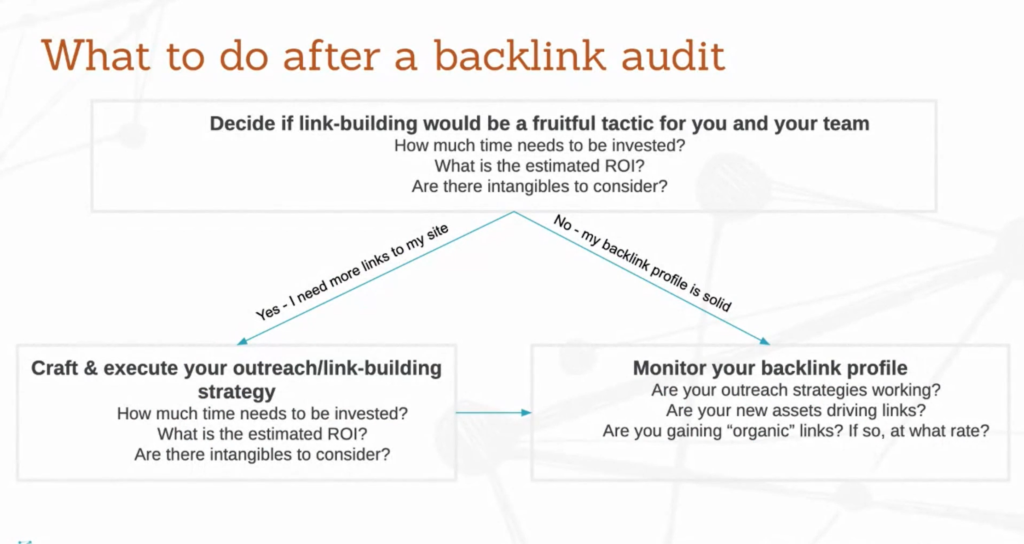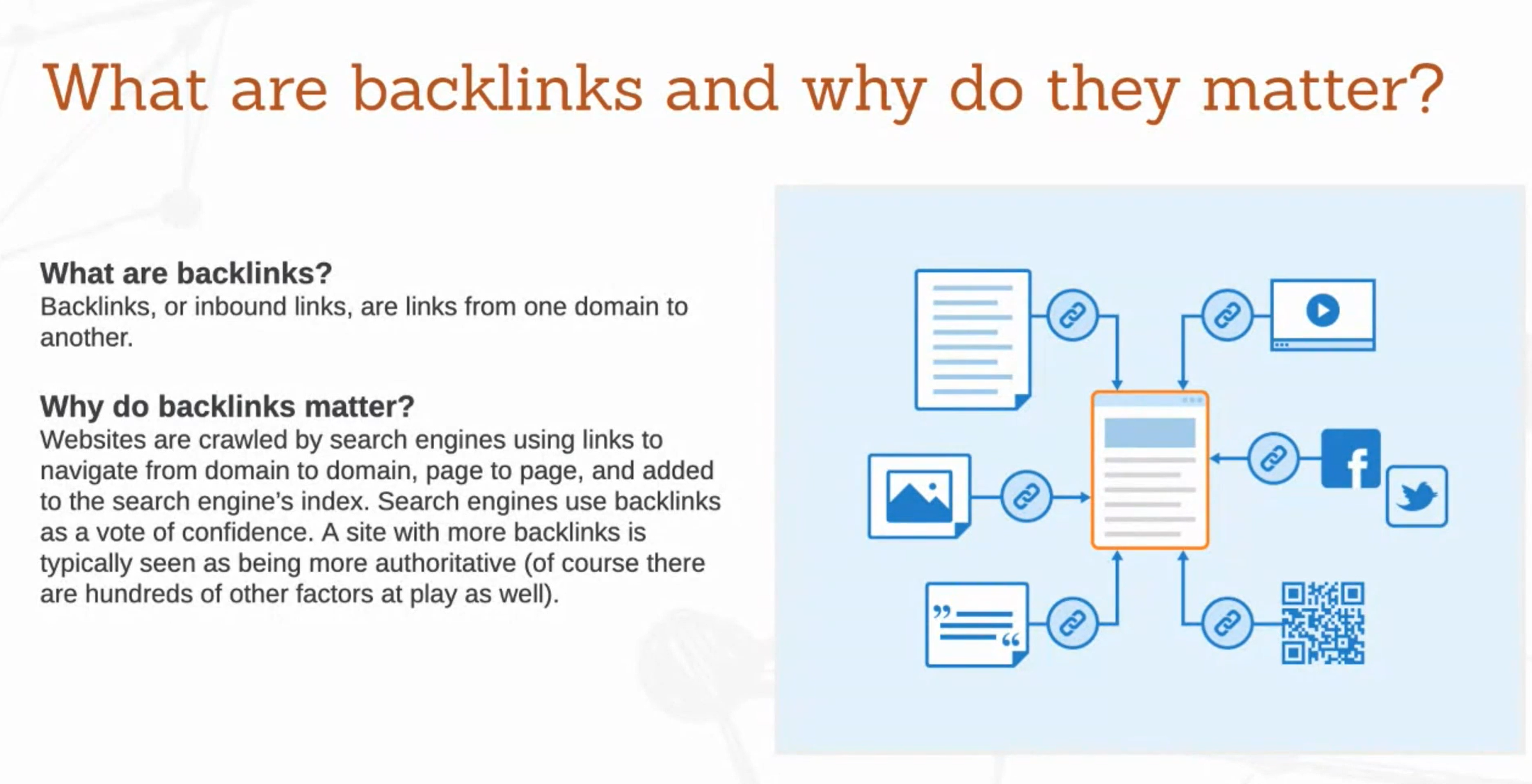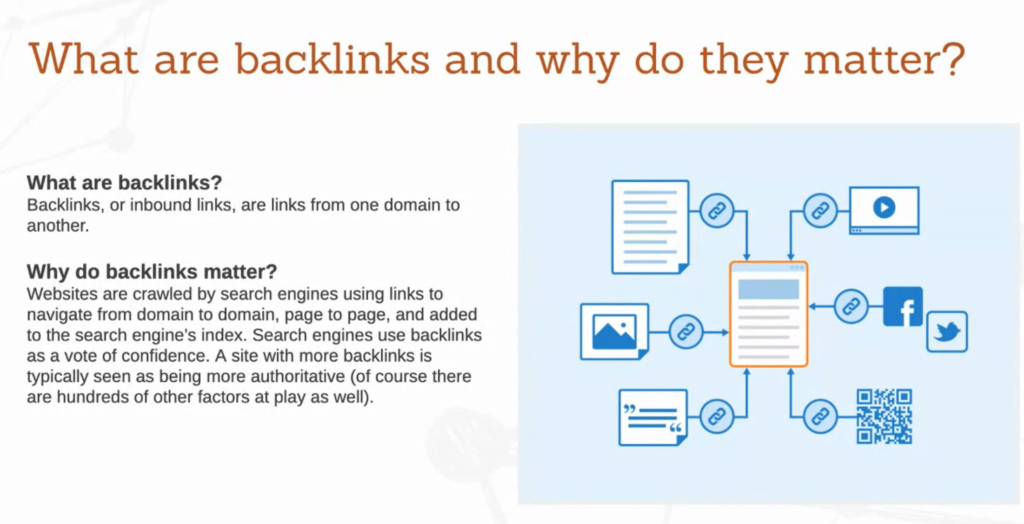Not sure whether to devote more time to inbound links and building a backlink strategy? Just follow the chart below!
In our last post on backlinking, we discussed whether inbound links are still important. As Zaine Clark shared at this year’s Found Conference, the answer is a resounding “yes.” As ranking factors, inbound links may fall behind site structure, content relevancy, or inbound traffic, but Google still assigns value to backlinks as a factor in search ranking.

Websites are crawled by search engines using links to navigate from domain to domain, and page to page — that’s because bots want to imitate humans when starting on your homepage. Google’s algorithms regarding links are constantly changing, but link-following is still how the web is crawled, and links still help determine site authority.
In short: backlinking doesn’t have to be your top priority, but it does need to be a priority. Let’s say you’ve completed a site audit, and determined that you need to up your backlink game. What does backlinking entail?
Make a backlink plan
First, you need to understand where creating backlinks fit into your overall strategy. Backlinking is, above all else, about creating great content — but, if you’re planning to do a great deal of outreach, you need to allocate adequate man hours to this initiative.
- Understand how much time needs to be invested. After your backlink audit, you should have a good idea of how your backlinks look, and whether you’re being penalized for any sketchy inbounds. Are you simply tweaking a few pages, or launching an entire campaign with backlinking in mind?
- What’s the estimated ROI, and how much time should you invest in backlinking? Make sure you understand the financial impact of moving up a slot or two in the SERPs, and focus on your most profitable keywords.
- Consider the intangible benefits to great backlinks. If organic isn’t a huge stream of revenue for you, what are you seeking to gain from better backlinks? Remember that backlinks imply authority to Google, and that that authority is communicated to your audience, in both Knowledge Panel and blue-link rankings.
- Who’s going to “own” backlinking outreach: you, your PR team, your client? If you want to ask other sites to link to yours, where should that request originate?
Again, backlinks alone won’t make your site an overnight SEO all-star, so consider how to incorporate backlinking into your larger strategy.
Count your assets.
Like everything else in SEO, backlinking changes frequently. What doesn’t change, however, is that linking is all about having something to link to. Look at your linkable assets. These may include:
- Infographics. These make great shareables, especially if you create embeddable infographics or ones that can be shared socially.
- Interactives. Think calculators and other tools that users may visit frequently, and that may respond to Google-able questions like “how much paint do I need for this room?” or “how much will my total mortgage be?”
- Studies, e-books, and white papers. If you’re in a research-heavy industry, create informational sources that other players may wish to cite in their own publications.
- Blogs. Look, you’re reading one right now! Newsworthy material can be really sharable, especially if you’re discussing information that the rest of your industry is talking about — and, especially if you have something new to add to the conversation.
- Product descriptions and how-tos. Detailed information makes even the sales side more linkable — especially if you sell a product that may require some background information.
Know what assets are already on your site, and which receive the most backlinks. Are you having replicable success with one type of content? If you plan to reach out to partners, what do you hope they’ll share?
Clean up bad backlinks.
Say you have tons of spammy backlinks pointing from irrelevant Russian sites or low-quality link farms to your pages. If you think your site is being affected by unnatural linking, try to:
- Find the contact information for the owners of sites that you believe are linking to yours in an unnatural way, and ask them to remove those links. Contact info is available through several domain-search tools, such as whois — but, you should prepare not to hear back, or to receive a request for paid link removal. Typically, link farms aren’t keen on patron services! If you are able to reach a real person, be sure to count your luck, and to be polite.
- If only certain pages are being affected by low-quality links, consider 404ing those pages and moving that content to new URLs. Of course, a high number of redirects can also signal trouble to search engines, so use your discretion.
- Google says you should only use the disavow tool if “you believe you have a considerable number of spammy, artificial, or low-quality links pointing to your site, and the links have caused a manual action, or likely will cause a manual action, on your site.” If those are true, go ahead and use Search Console’s disavow tool.
Google itself provides the means to disavow those spammy links, but says that other measures should come first. When possible, clean up unnatural links naturally.
Do your outreach.
Backlinkio points out that an email begging your target to link to a page is…not the most appealing course of action. If you want to build links effectively, you must provide your potential partners with some sort of value. A few ways to make a mutually beneficial offer:
- Offer to provide a guest column for the blog of a related organization — and link that expertise to your page.
- Offer to host a guest column from a third-party expert — and encourage that writer to link to the column from their own site.
- Search for unlinked mentions of your brand, then ask the owners of those mentions to link to your site. This provides a better on-page experience for their users, and a backlink for you.
- If you have embeddable tools, graphs, and videos relevant to your industry, offer those directly to other content creators.
- Become a source for other publishers and journalists covering your industry. Sites like HARO (Help a Reporter Out) connect content experts with reporters seeking quotes and knowledge on industry-specific topics.

Remember that backlinks aren’t just part of technical SEO — they’re about playing a valuable role in your industry’s informational sphere. As you reach out to potential partners, use a personalized contact template for each potential partner. Your outreach communication should highlight the usefulness of your information, and of your potential link-sharing.
Remember that good backlinks aren’t created by bots.
The best backlinks come from the most authoritative, useful, high-traffic websites — in short, those with great content. Building backlinks isn’t just about pleasing bots. They’re a sign that your creative content is working, and that other people find it valuable — even valuable enough to share. If your content isn’t earning links, you may not need to
Moving forward, use your backlink tracking tools frequently. Analyze your profile and your competitors’ profiles frequently. And, as Zaine says, continually monitor whether the juice is worth the squeeze. You may not need to create an extensive outreach campaign regarding backlinks. In fact, you may only need more, and better, content.
Ready to commit to making SEO-friendlier content, but not sure where to begin? Contact us and we can get started on a plan.

